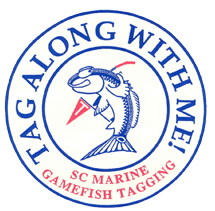Marine - Species
King Mackerel (Scomberomorus cavalla)
General Description
Back iridescent bluish-green; sides silver; first dorsal fin with light and uniform pigment and 14 – 16 spines; snout much shorter than rest of head; posterior maxilla (mouth) exposed and reaching posterior portion of eye; lateral line with abrupt downward curve at second dorsal fin.
Average Size
33 inches, 10 pounds;
South Carolina State Record: 62 pounds (1976);
maximum age: approx. 14 years
Habitat
King mackerel prefer warm, clear waters; all phases of development occur over continental shelf, including both nearshore and offshore habitats and live bottom.
Adults: Older fish inhabit high salinity, green ocean waters, near the surface or at moderate depths. May move inshore on higher tides and during summer. Often associated with outer reefs, wrecks, towers, and buoys.
Juveniles: Occur from mid-shelf to inshore waters and from the surface to moderate depths in water column. Individuals caught near fishing piers are typically older juveniles.
Reproductive Cycle
- Both sexes mature at 3 – 4 years of age; approx. size at maturity: males – 28 inches, females – 32 inches.
- Spawning occurs between Gulf Stream and high turbidity zone in nearshore waters. In South Carolina, spawning occurs April – September.
- Larvae remain in high salinity waters throughout development. Larvae may be present across continental shelf, but are often most abundant in middle to outer shelf waters.
Foraging Habits
- Adults and juveniles are prey on herring, anchovies, jacks, and menhaden. Juveniles also consume some squid and shrimp.
- Diet of larval king mackerel consists exclusively of fishes.
Availability/Vulnerability to Harvest
- Distribution is governed by temperature and salinity. Annual migration from South Carolina waters to overwintering grounds in south Florida occurs during fall. Northward migration occurs during spring and early summer.
- Smaller fish move in schools, older fish occur individually or in small groups. Tendency to associate with hard structure such as fishing piers may increase fishing pressure.
- Conservation concerns: potential for overfishing (especially in south Florida overwintering grounds); migratory nature increases management difficulty.
Literature Cited
Berrien PL, D Finan. 1977. Biological and fisheries data on king mackerel, Scomberomorus cavalla (Cuvier). U.S. Dep. Commer., NOAA Natl. Mar. Fish. Serv. Sandy Hook Lab., Tech. Ser. Rep. no. 8, 40 pp.
Collins MR, BW Stender. 1987. Larval king mackerel (Scomberomorus cavalla), Spanish mackerel (S. maculatus), and bluefish (Pomatomus saltatrix) off the southeast coast of the United States, 1973 – 1980. Bull Mar Sci 41: 822-834.
Fischer W. 1978. FAO identification sheets for fisheries purposes: western central Atlantic (fishing area 31) volume 1 – 7. Food and Agriculture Organization of the United Nations, Rome.
Godcharles MF, MD Murphy. 1986. Species profiles: life histories and environmental requirements of coastal fishes and invertebrates (south Florida) – king mackerel and Spanish mackerel. U.S. Fish Wildl Serv Biol Rep 82(11.58). U.S. Army Corps of Engineers, TR EL-82-4. 18pp. Accessed: September, 2009.
Goldstein RJ. 2000. Coastal fishing in the Carolinas: from surf, pier, and jetty. John F. Blair Publisher, Winston-Salem, NC. 243 pp.
Moore CJ. 1996. A field guide to the identification of marine species regulated in South Carolina coastal waters. Office of Fisheries Management, Marine Resources Division, South Carolina Wildlife and Marine Resources Department, Charleston, SC. 105 pp.
Moore CJ, M Barkley. 2005. South Carolina's guide to saltwater fishes. South Carolina Department of Natural Resources, Special Publication. Columbia, SC. 132 pp.


